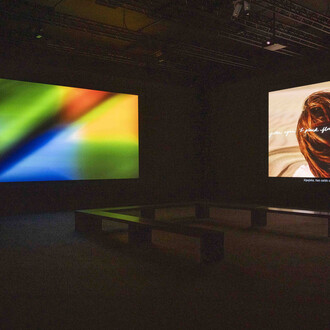Conserved in Bilbao, the Arriola-Lerchundi Library is a private compilation of extraordinary artistic and documentary importance due to its volume and quality. It encompasses almost 20,000 printed items—including 140 incunables—and 15,000 manuscripts and is the outcome of the collecting efforts of the Bilbao notary José María Arriola and his wife Rosa Lerchundi, who for decades visited auction houses, fairs, antiquarians and bookshops specialised in book collecting all over the world.
The library is now being shared with the public through a selection of forty manuscripts dating from the twelfth to nineteenth centuries representing the excellence of a collection, which has been recognised by experts and bibliophiles, whose goal is to conserve and study historical books.
Different types of documents can be found in the exhibition, from prized books of hours to letters of royal privilege or executory certificates of nobility. Another item that stands out for its rarity is a Bible in Basque, while two letters signed by Francisco de Goya and a music score handwritten by the Bilbao composer Juan Crisóstomo de Arriaga are also striking for their historiographic interest.
The selection, curated by José Luis Merino Gorospe, the museum’s Curator of Ancient Art, is displayed in chronological order and contextualised with works from the museum’s collection—eleven paintings, one sculpture, one watercolour and two photographs—chosen for their artistic interest and historical or iconographic proximity to the content of the manuscripts.
Exhibition itinerary
Introduction
The Arriola-Lerchundi Library brings together around 20,000 printed items (including 140 incunables) and 15,000 manuscripts. Due to its volume and quality, it is an assemblage of extraordinary artistic and documentary importance which has grown since it was started in 1966 thanks to the bibliophilic passion of the Bilbao-based notary José María Arriola and his wife Rosa Lerchundi. Known in expert circles, it is now being presented to the public via forty manuscripts dated from the twelfth to the nineteenth centuries.
They include letters of royal privilege, executory certificates of nobility, pragmatics, liturgical books and beautifully illuminated books of hey also include an unusual Bible in Basque, two letters signed by Francisco de Goya and a score also signed by the composer Juan Crisóstomo de Arriaga. These unique documents are being exhibited along with artworks from the museum’s collection that are from the same period or are thematically related. Thus, art history and bibliophilia converge thanks to the rarity, beauty and historical importance of all these works.
Room II
This room contains extraordinarily aesthetically beautiful documents, such as royal privileges and other appointments. The liturgical documents include a processionary with musical pieces and especially books of hours, which are given this name because they contain different prayers depending on the canonical hour. The latter, veritable gems of mediaeval and Renaissance art, were made on vellum (parchment made from calf skin), first in monastic scriptoria and later in specialised workshops. The document from Pope Clement VII excommunicating King Henry VIII of England is also displayed.
Thanks to several fourteenth-century treatises on materials and procedures for illuminating manuscripts—such as the anonymous De arte illuminandi and the Libro dell’Arte by Cennino Cennini— we know that many of the pigments used were similar to those used in other techniques. What stand out in this set is organic plant- based pigments, like indigo blue, red lacquer from the palo rojo tree, Brazilwood and cochineal. Lapis lazuli was the most valuable and beautiful of the blues. Gum Arabic and egg white were used as binders. The calligraphies called chrysography and argyrography were achieved with ground gold and silver, respectively, and they were used in the capitular letters and the glimmers emanating from clothing and halos, among other places.
Room III
Executory certificates of nobility judicially confirmed a subject’s nobility, which brought them social prestige, privileges and tax benefits. To achieve this recognition, a request had to be submitted to one of the two royal chancelleries in Valladolid and Granada. Once secured, the applicant’s copy could be decorated with religious motifs, depictions of members of the family as donors or other elements alluding to the nobility of the family line, often coats-of-arms. The number and quality of the images depended on the customer’s economic capacity. Similarly, rolls of arms included repertoires of painstakingly coded coats-of-arms. Likewise, portolan charts are sailing maps that accurately describe the Mediterranean coasts, in contrast to painters’ intuitive vision of the planet. This displays the contrast between science and invention, which shared the common denominator of beauty.
Sala IV
This room displays religious and secular documents, including a 1630 copy of the Fuero viejo de Vizcaya [old charter of Vizcaya]. It also contains important texts in Basque, like a collection of letters between French authorities and the Valle del Roncal, and Pierre d’Urte’s translation of the Bible dating from 1700, which is extraordinarily important in what it reveals about the language. The Crónicas de Vizcaya [chronicles of Vizcaya] by Miguel de Alonsótegui, which had been lost for many years, contains important information on what is now the Basque Country during the sixteenth century. This room also contains an exchange of letters between Goya and representatives of the Bilbao Town Hall about the commission of a portrait of Manuel Godoy whose whereabouts we do not know, if it was ever actually painted. A signed fragment of the score of Los esclavos felices [the happy slaves overture] by the Bilbao composer Juan Crisóstomo de Arriaga completes this section of rare documents.
















